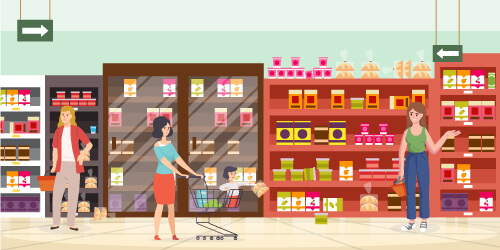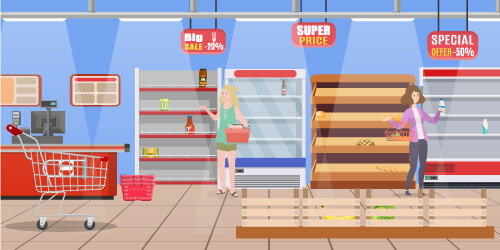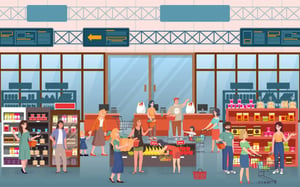Let us know if this sounds familiar: You walk into a store to do some shopping, and by the time you leave, you’re so frustrated and angry that you promise never to go shopping there again - ever. Whether it’s because the store never seems to have what you need or the aisles are messy, for some reason, this particular store makes you hate shopping.
We can tell you with certainty that you’re not losing your mind - there are GOOD REASONS why you don’t want to shop at a particular store. And all of them are justified.
That leads to a question: can these stores fix these mistakes? In short, yes! And it’s the subject of this article. There are reasons why that one store never meets your expectations or always seems to be missing those products you need the most, and we’ll touch on why it happens.
Do you hate shopping at a particular store? Let’s have a look at why you feel that way.

1. You can't find what you're looking for
Have you ever walked down the aisles of a store, eyes scanning the shelves for something you’re sure would be there, only to learn that it's nowhere to be found? It's not only not in that aisle but it's also not on any other shelf in the store.
You know that because you flagged down a store employee, and they looked at you blankly as you tried to explain what you wanted before shaking their head. Nope, they don't have it. Frustrating, right? We don't blame you!
That's especially true if there should be no doubt that the store should have the product.
So why is this happening? The long answer is that they haven’t figured out which items they need to stock to satisfy their customers, including you.
From a retail and category management standpoint - and here’s the short answer - it’s because they haven’t completed an assortment planning exercise.
Assortment planning is the process of selecting which products to stock to cater to shoppers. It considers the financial objectives and seasonality of a product selection so that everyone - the retailer and the customer - wins.
Assortment planning lets the retailer stock the products you want while taking into account the needs of all the customers around you as well. They work to optimise the range of products available to you by using specialised software such as DotActiv as well as the various functions found within such as the Range Optimizer tool.
This allows them to create a product range offering which optimally satisfies the needs of each consumer grouping, or cluster, within a target market.
These tools help the retailer to predict consumer demands by selecting the most beneficial products - to both you and the retailer - to plan around.
Effective assortment planning identifies:
- Your needs, which are reflected in the historical sales data. This allows them to understand which products you are most likely to purchase as well as how often you’ll purchase these products.
- Once identified, retailers will add these items to their product mix and place them on the shelf for you to find and buy them.
Why do you think you enjoy shopping at one store over another? If it’s because they always have the products you like, they’ve likely considered their data and completed an assortment planning exercise.

2. The store is messy and disorganised
There is nothing worse than stepping into a store that is in a state of chaos. From unorganised shelves to no logical flow of product categories between aisles or a confusing jumble of different products crammed into the wrong spaces with no price labels.
Any shopper in their right mind would turn around, and make a hasty exit. If that’s you, and this is the main reason why you refuse to step into a store again, we don’t blame you. We agree with you - it’s not right!
Modern retail requires careful planning and organisation to ensure that you, the customer, receive the best possible experience in-store while making sure that the retailers themselves max out their potential to give you what you want - order and a clean, well-managed shopping environment.
One way of doing that is by using data-driven planograms. Any retailer interested in pleasing you and caring about how you experience their store should consider them.
Data-driven planograms are like blueprints for retail perfection. They allow retailers to optimise the space available to them while ensuring that every product has a place that is suited to the overall flow and aesthetic of the store.
These planograms make use of category tactics to ensure that product arrangements look good but - more importantly - are relatable and easy for you to understand. This prevents a phenomenon called ‘analysis paralysis’ where customers are overwhelmed by the sheer disorganisation in front of them, unable to make sense of the variety of products before them.
Data-driven planograms introduce consistency and logic to the look and feel of stores, adding important benefits for retailers and customers alike. As a daily, weekly or monthly customer of a store, when a retailer implements planograms correctly in-store, you can expect the following:
- A store that will meet your basic needs as a customer;
- A store that focuses on ensuring your shopping experience is enjoyable;
- A store that lays out its products in a logical, easy-to-understand manner; and
- A store that you’ll want to return to.
The next time you visit a store and see that it’s messy or disorganised, you’ll know - they don’t use planograms. We also suggest you go to another store. Why?
A store that uses data-driven planograms cares about providing you with a shopping experience that you’ll enjoy.

3. It's too busy whenever you visit
You hate shopping in a store that doesn’t stock the specific products you want when you want them. That’s fair. We do too. There’s nothing more frustrating than that.
But what about a situation where you walk into a store and you’re met with a throng of people in the aisles. Or when you’re ready to shop, list in hand and before you even enter the store, you see it’s overcrowded.
Can you feel your heart drop into your stomach? The last thing you want to do is elbow your way through people to get to the items on the shelf. And while we’re living through a pandemic. No thanks!
In an era of COVID-19, retailers must be smart in helping you to browse their stores. From encouraging social distancing to getting people in and out as quickly as possible, the solution to keeping shoppers flowing through uncongested stores lies in the art of floor planning.
In truth, COVID-19 shouldn’t be the guiding factor for retailers to implement data-driven floor planning.
Floor planning is an often-overlooked element of retail optimisation that allows retailers to lay out their stores so that you can navigate through the store from the entrance to the checkout points smoothly and easily. It uses data to determine the most logical flow based on considerations extracted from looking at the consumer decision tree.
Floor planning identifies what is known as hot spots and cold spots.
- Hot Spots: Areas in a store with a high concentration of customers. Floor plans seek to avoid creating too many hot points because these areas take customers away from other parts of the store and cause store and floor congestion.
- Cold Spots: Areas in a store which see fewer customers. This can be due to the product categories being low in demand, or because they’re in hard-to-reach areas of the store.
Either way, the goal of a floor plan is to guide you past as many products as possible (cold spots included) to increase your basket size. The trick is to do it in a way that provides you with a pleasant shopping experience.

4. The store is always out of stock
Nothing inspires rage (justified or not) like an empty shelf, right?
Imagine this - you visit a store, ready to buy something only to find that it doesn’t have what you need. Did you want to cook up that amazing dish for your partner to celebrate your anniversary? Tough luck!
But then again, tough luck for that store because there’s no way you’re going to return.
There are many reasons why the store is always out of stock. But one of the main ones is that they’ve failed to look at their retail data and understand which products and how many of each to stock to meet demand.
By analysing the data on a regular basis, stores can spot trends. Patterns can be identified to anticipate how the stock of certain products behaves seasonally, allowing retailers to determine whether a stock level indicator is normal or out of the ordinary and thus prepare by ordering the right amount of new stock at the right time.
Retail stock data analysis is measured through a metric called Days of Supply (DOS) - basically how long it takes for a product to run out before the store needs to restock the shelf.
DOS is also key to allowing retailers to build planograms that improve stock turnover. The planogram shows you how many products can fit on a shelf and then calculates the average units sold per day while looking at how many are left. This provides a perspective to a retailer on how often they will need to stock their shelves.
This makes the planogram a powerful tool in helping retailers understand how to get the biggest return on product investment while ensuring that stock quantities are in balance with your needs.
The result? You get to shop at a store which has fewer (if any) empty shelves. More importantly, no rage. Because the store you’re visiting knows that if they want you to return, they need to look at and understand their retail data.
Conclusion
Nobody likes shopping in a store that doesn’t live up to expectations and everyone hates visiting one that promises one thing but does something else altogether. We know that, which is why we’re in the business of helping stores provide you with the best possible shopping experience.
It just happens that they can increase their sales and profits too.
Stores that employ effective category management solutions, like those offered by DotActiv, can mean the difference between a complete shopping experience that will have you visiting again and again and one that leaves you angry and frustrated, vowing never to return.
So the next time you find yourself in a fit of rage at any one of the things that so often drives you crazy, stop and ask the floor manager if they’re running an effective category management solution. If not, let them know they should seriously consider implementing one and point them to DotActiv.
If you work in the retail industry and know you could benefit from a category management solution from DotActiv, book an exploratory consultation with one of our experts here. We will talk you through all the aspects that’ll help you to please your customers and maximise your sales.
About the contributors
Caylin Fortuin joined DotActiv in 2021 as a category planner, working on the Dis-Chem account to provide our end-to-end category management services. She has since rotated to our UPD account, where she delivers data-driven planograms and provides expert category management advice. She has a Bachelor of Commerce (Honours) in Marketing Management from the University of Pretoria.
Micaela Halim joined DotActiv in 2021 as a category planner. Since joining, she has worked on a few accounts including at Dis-Chem. She has since moved over to work on our Ultra Liquors account. She has a Bachelor of Commerce in Business Innovation and Entrepreneurship from AFDA.
Michael Puckering joined DotActiv in 2017 as a space planner. Since then, he has worked on various accounts, gaining extensive experience across different retail environments. Currently, he works on the ACDC account.


